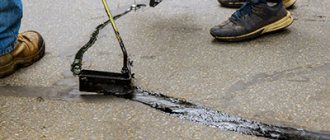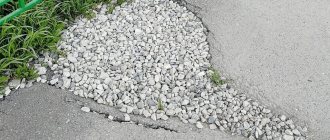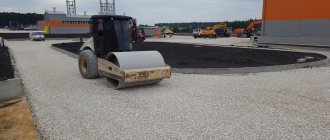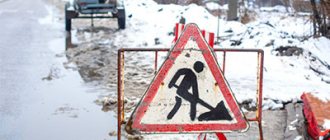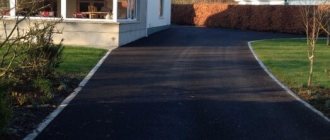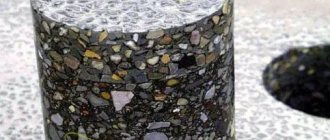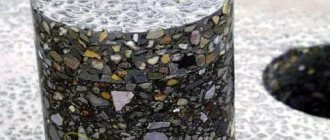- Road paving
- /
- Categories
- /
- Pothole repair of asphalt pavement
Even the most reliable coating device fails sooner or later. Asphalt is a soft material that tends to wear out. The top layer of the coating is called the “wear layer”. Laying asphalt with replacement of side stones is used if the number of defects in the road surface exceeds 12-15%. For smaller scale damage, asphalt patching is carried out, which will ensure safe and comfortable driving on the road at a low cost. It is the filling of holes that is the most common type of current asphalt paving. The quality of repair work directly depends on adherence to technology and the choice of asphalt concrete mixture.
Price for pothole repairs for 2022
| n\n | List of works performed | Unit change | price, rub. |
| 1. | Site visit, consultation and budget preparation | m2 | For free |
| 2. | Pothole repair of asphalt pavement (fine-grained 4-5 cm) | m2 | 620 |
| 3. | Pothole repair of asphalt pavement (sand 4-5 cm) | m2 | 660 |
| 4. | Pothole repair of asphalt pavement (coarse grain 4-5 cm) | m2 | 670 |
| 5. | Cutting asphalt maps 5 cm thick with a diamond blade. Dismantling and disposal | m.p. | 95 |
| 6. | Pouring cards with bitumen emulsion | m2 | 35 |
| 7. | Repairing road cracks | m.pog | 280 |
Asphalt is the most popular material for creating road areas. Its reliability and practicality have been tested over the years. The variety of brands makes it possible to create road surfaces in Moscow on highways, intercity highways, yard communications, and sidewalks.
Asphalt consumption per m2 with a layer thickness of 1 cm
Our many years of experience have given us the opportunity to formulate a clear action plan and identify average asphalt consumption values per 1 m2. We did this to facilitate our work and to conveniently calculate asphalt consumption by the customer.
Asphalt consumption per 1 m2 with a layer thickness of 1 cm:
- fine grain raft. type A m I - 25.7 kg.
- fine grain raft. type B m I, m II - 24.6 kg.
- fine grain raft. type B m II - 24.9 kg.
- sand raft type G m II - 25.0 kg.
- sand raft type D m II - 23.2 kg.
- fine-grained pore. m I, m II - 24.8 kg.
- coarse-grained pore. m I, m II - 24.2 kg.
- crushed stone-mastic -15 - 25.8 kg.
- crushed stone-mastic -20 - 25.7 kg.
We can conclude that the approximate consumption of asphalt per 1 sq.m. with a layer thickness of 1 cm it is equal to 25 kg. That is, when paving in 1 layer according to GOST thickness. 4-5 cm, you will need 100-125 kg of asphalt.
Calculation of material consumption
In order to correctly calculate the consumption of asphalt concrete during asphalt paving , you need to know the total area of the territory, thickness. layer and type of mixture. The type of mixture can be determined after a free visit from our engineer.
Calculation example for clarity
For example, we have an area of 1000 m2, and we need to perform asphalting with a thickness of H=4 cm:
1) 25.7 kg * 4cm = 102.8 kg - the number of m/z of dense asphalt mixture type A m I, for 1 m2 of asphalt laying.
2) 0.103 t * 1000 m2 = 103 tons - the amount of asphalt concrete required for paving the territory.
The amount of asphalt given in the calculations that is required to lay 1 cm of asphalt pavement is approximate. To prepare an estimate, you need to call a competent specialist who will correctly calculate all costs based on your property. You can do this by contacting our company at +7(988)564-71-76 or leaving a request on the website. We will come to you free of charge and advise you on the spot!
Different methods of filling holes and potholes on the road
Construction technology is constantly being improved, new additives appear in the asphalt concrete mixture, which prevent damage to the road surface and reduce the cost of operating transport networks. Small cracks inevitably increase in size due to sudden temperature changes. When water gets inside road slabs, it expands when it freezes and breaks the pavement structure, turning a small pothole into damage the area of which is measured in m2. Therefore, pothole repair of roads is an important job to preserve their performance qualities, which we will perform for you at the highest level.
Leave a request Call back
Types of defects
Structural violations of the road surface may vary. In this regard, they are classified as:
- Drawdowns. In this case, we are talking about distortion of the road profile. The drawdown looks like a depression with gentle edges.
- Ruts. A very common problem is distortion along the knurling line.
- Breaks. Serious damage affecting the structural layers of asphalt concrete.
- Chipping. This happens when parts of the mineral composition begin to fall out.
- Edge damage. It is not uncommon to see ragged edges appear where the road meets the shoulder.
Also, shifts, waves, peeling, and cracks in the form of a grid or single ones may appear on the road surface. The variety is simply enormous, and the reasons for the appearance of such defects are even greater.
Pothole work with hot mix asphalt
Hot mix asphalt and cast asphalt, prepared from sand, crushed stone, bitumen and mineral additives, are used to repair roads of the first and second categories. The mixture heated to 150 degrees is delivered to the site in specialized bunkers that can hold up to 4 m 3 of product. A mixture that has cooled below 110 degrees is considered defective. Transcom cooperates with many asphalt concrete plants and has the ability to quickly deliver the mixture even to remote sections of roads under construction. The universal hot method is affordable, but has one significant drawback. Repair work can only be carried out in the warm season and in dry weather.
Preparatory work before patching asphalt consists of the usual set of operations:
- leveling
- cleaning
- priming the surface of the concrete base
Laying and compaction of mixtures is carried out by specialists using standard equipment: asphalt pavers and rollers. The asphalt surface after the passage of equipment has a smooth texture without cavities, cracks, tears and other defects.
Cold patching of roads
Cold asphalt is a name for mixtures that are higher than traditional ones in price per unit. measurements. They contain special additives, bitumen. For each component, a special temperature regime is provided during the preparation of the mixture. The cost of cold bitumen-containing composites is compensated by the versatility of use. Work is carried out at any time of the year, including at sub-zero temperatures. Preparation involves removing dirt and excess moisture from the crack or hole. Cold asphalt does not require additional compaction. The movement of vehicles through the repaired area will provide the necessary density to the coating.
The strength and water resistance of cold mixtures is lower than hot ones, so they are used for repairing roads of the third and fourth categories. Pothole repair at a reasonable price per m2 using bitumen emulsions is relevant for emergency repairs and repair of minor defects.
Tamping
The effectiveness of the repair, in addition to the quality of the cold asphalt, also depends on well-executed compaction, which is carried out to obtain the required degree of compaction.
The asphalt concrete layer can be effectively compacted using the following types of equipment:
- Hand rollers, which belong to the category of the simplest compacting devices.
- Vibrating plates. Powerful units are ideal for compacting the asphalt layer in large potholes, and for small holes or in confined spaces it is more advisable to use compact vibratory rammers.
Cast asphalt
A mixture of sand, gravel and ground limestone with a sufficiently large amount of natural and petroleum bitumen is called mastic asphalt. The mass is easily smoothed by hand due to its mobility when hot.
The liquid consistency ensures the installation of a dense cast layer that does not require additional compaction. The high moisture resistance of the coating allows you to seal potholes even during precipitation. Casting temperature - 180-250 degrees. Excess moisture on the base at this temperature instantly turns into steam, the edges of the coating are fused into a single whole with the mixture being poured. Cast asphalt is ideal for emergency work in freezing temperatures and during rain. Call Transcom, our specialists will help you choose the most convenient asphalt paving method for each specific case.
Recycling and jet injection methods
Economical modern technology involves recycling asphalt concrete material and using it to repair road surfaces right on site, without removing materials. The asphalt dismantling products are heated and mixed in a specialized machine, a recycler. Bitumen is added to the asphalt crumbs and used immediately. The use of this practical technology, instead of using a sand cushion and fine-grained crushed stone, reduces the price per m2 by half.
Jet-injection technology involves performing all existing repair operations with one machine. The repair area is subjected to blowing with a high-speed air stream, instant washing and application of bitumen emulsion. Milling of asphalt concrete is not carried out. The pothole is filled with small crushed stone and bitumen emulsion. High speed air flow ensures good compaction without vibration rolling.
How road defects can be eliminated
There are removable and irremovable defects. In the second case, we are talking about the fact that the asphalt concrete is so damaged that there is no point in repairing it; the canvas needs to be completely replaced. Removable damage includes minor defects in the so-called road pavement, which can be eliminated without global intervention. Let's consider all the options.
Complete replacement of the canvas
A major overhaul implies that all the necessary studies of the route are carried out again, compliance with standards is checked and errors that were made earlier are found.
Healthy! An important stage is soil research, including a detailed study of the composition of the underlying layer.
If it is decided that the route no longer meets operational requirements, then the asphalt concrete pavement and its base are dismantled. Old asphalt is hauled by dump trucks to factories where the material is recycled for reuse. After this, a new underlying layer is equipped, and new road pavement is laid (preferably using new technology and using more modern solutions). After this, the highway can be assigned a different category in accordance with its cross-country ability.
How to prepare a road for pothole repair
The main key to success is compliance with the technological requirements and standards defined for each type of mixture.
- Potholes and cracks are marked with straight lines along the axis of the road and across it. The reserve of the undamaged layer should be at least 3-5 cm.
- Removing coating from small potholes using a jackhammer. Removing coating from narrow potholes, the length of which exceeds 3 m2, is done using a cutter.
- The pits are cleared of crumbs and dust. The walls are treated with liquid bitumen or emulsion. There should not be too much liquid, otherwise the quality of adhesion of the new layer to the old one will decrease.
The prejudiced attitude towards filling potholes is largely due to a careless attitude towards the construction of foundations. High-quality work will keep the asphalt concrete surface free of potholes for many years, allowing you to comfortably move along the repaired roads.
The price of pitting in ours is democratic and affordable. Order asphalting and road repairs in Moscow and the Moscow region from us. Don't put off worrying about creating communication routes. The cost of getting rid of one of the two eternal problems in our country is not at all great. And this price is definitely less than the losses incurred by the national economy, which suffers from the lack of good roads.
